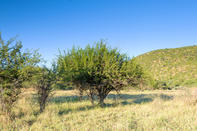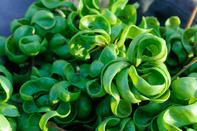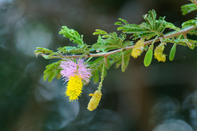
Sickle Bush Appearance
The leaves of the sickle bush are soft and feathery. Like other parts of the tree, they are nutritious and are also used in a number of medicinal applications. They make an effective local anaesthetic for topical application.
They can even be ingested to relieve internal aches and pains. Toothache can be relieved by inhaling the steam from boiling roots and leaves and chest complaints can be relieved by inhaling the smoke from burning roots and leaves.
The sickle bush’s bark has long fissures. By powdering the bark, skin conditions of various kinds can be treated. The inner bark is used to treat toothache and stomach complaints. The flowers of the sickle bush are the most unique and striking of bushveld flowers.
The bush produces two-tone spikes with pink on the top and yellow below. The genus name Dichrostachys refers to this characteristic of the tree. The flowers look like miniature Chinese lanterns and the tree is sometimes referred to as the Chinese lantern tree. The decorative flowers are present on the tree (quite appropriately) over the Christmas season.
The clusters of contorted pods produced by the sickle bush are unmistakable and are relished by animals for their high nutritional value. The sickle bush is often confused with the acacia trees but the sickle bush is not an acacia because it does not have thorns but rather spines.
Spines are defensive spikes produced by the tree through the modification of branches whereas thorns are modified leaves. Both acacias and sickle bush are considered fine leaved trees and tend to occur in the lower part of the catena (in the more fertile soils).
The sickle bush is a very nutritious plant and virtually the whole plant is eaten by animals, especially elephants. It produces these hard spines to limit the amount of herbivory taking place on the tree.
Sickle Bush Uses

The sickle bush is the A-Z of medicinal plants and is used successfully for numerous conditions including stomach complaints, pneumonia, abscesses, dysentery, gonorrhoea, and worms. Sickle bush has antibiotic properties.
The inner bark of the sickle bush can be used to make a very strong, reliable rope. The rope or twine is traditionally used to facilitate the healing of scorpion stings and snake bites. The chewed root (or leaves) is applied to scorpion stings and snake bites and then bound onto the wound with the twine from the tree. The same treatment can be given to irritating insect bites.
Sickle bush produces very strong, hard wood. It is one of the best woods for making tool handles because of this. The pieces are seldom very thick but always strong. Sickle bush wood burns well in spite of the thinness of its trunks.
The hard wood means that sickle bush poles are termite resistant and long lasting. They are often used to substitute iron uprights in fencing as they can even withstand fire. The sickle bush is sometimes grown in the vicinity of homes to ward off evil spirits. Charms from the tree are also kept for the same purpose.
An eyewash can be made from an infusion of the seedpod to relieve eye irritations and sometimes the pods are collected for decorative purposes. The leaves of the sickle bush are soft and feathery. Like other parts of the tree, they are nutritious and are also used in a number of medicinal applications.
They make an effective local anaesthetic for topical application. They can even be ingested to relieve internal aches and pains. Toothache can be relieved by inhaling the steam from boiling roots and leaves and chest complaints can be relieved by inhaling the smoke from burning roots and leaves.
Sickle Bush as an Environmental Aid

Sickle bush is one of the major native encroachers in the bushveld. It quickly colonises disturbed areas, particularly those that have been overgrazed or previously cultivated. This tree gets the competitive advantage over other indigenous species because it can grow in all soil types.
It coppices readily from any small piece of the root and the seeds are not digested when they get eaten. The seeds pass out of animal’s gut untouched and are deposited in a ready-made pile of compost especially if deposited by elephants!
Bush clearing programs are often initiated to clear the impenetrable thickets that eventually form from this aggressive encroacher. Fortunately, the wood produces excellent coals and so the cleared stems can be sold as firewood (or charcoal) and the money recycled back into the rehabilitation of the land.
Sickle bush branches are often used in brush or mattress packing operations to reclaim eroded or barren areas. By placing the branches over the surface of the ground they serve to trap windblown debris and to slow the flow of water over the surface of the soil. The slowed water is then able to infiltrate the ground and also allows soil particles and seeds to be deposited.
Eventually, enough of a deposit will allow the seeds to germinate in the improved growing conditions of the area. The spines on the branches prevent unwanted passage over the area by animals and also shelter the newly germinating seeds. The branches break down over two or three seasons leaving a transformed area.
Sickle Bush Fast Facts
Height - 5 to 7 m
Growth form - Spreading, tangled bush to small tree, often multi stemmed
Leaf type - Bi-pinnately compound
Leaf arrangement - Alternate
Leaf margin - NA
Habitat - Diverse but thrives on overutilized lands and in clay soils
Deciduous or not - Deciduous
Most notable fruit/flowering season - Pod May to Sept, Flowers Sept to Jan
By Megan Emmet